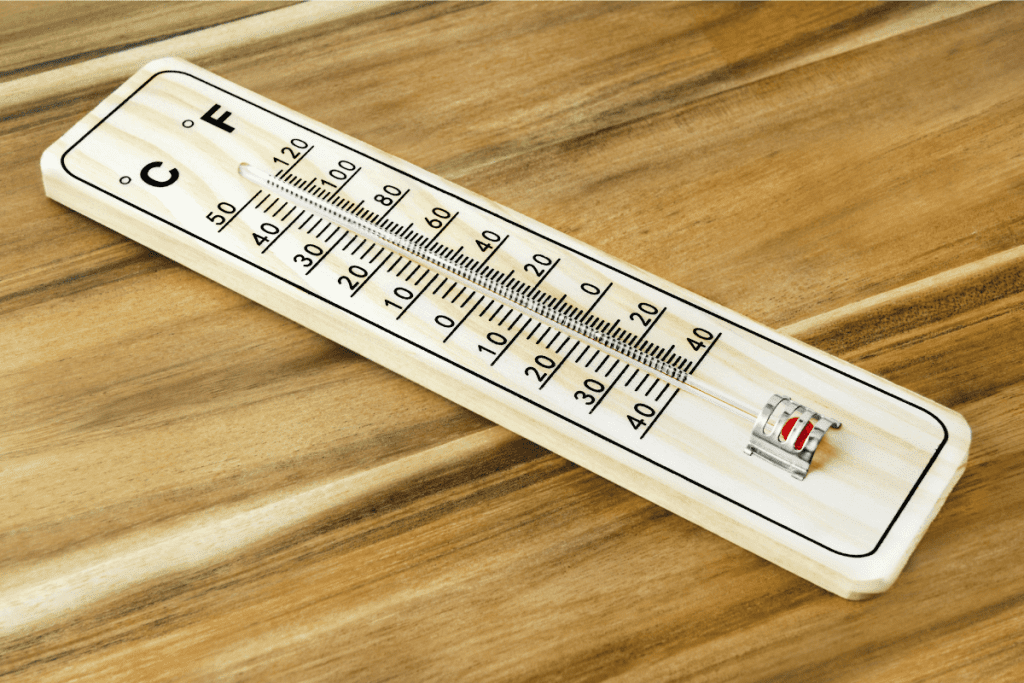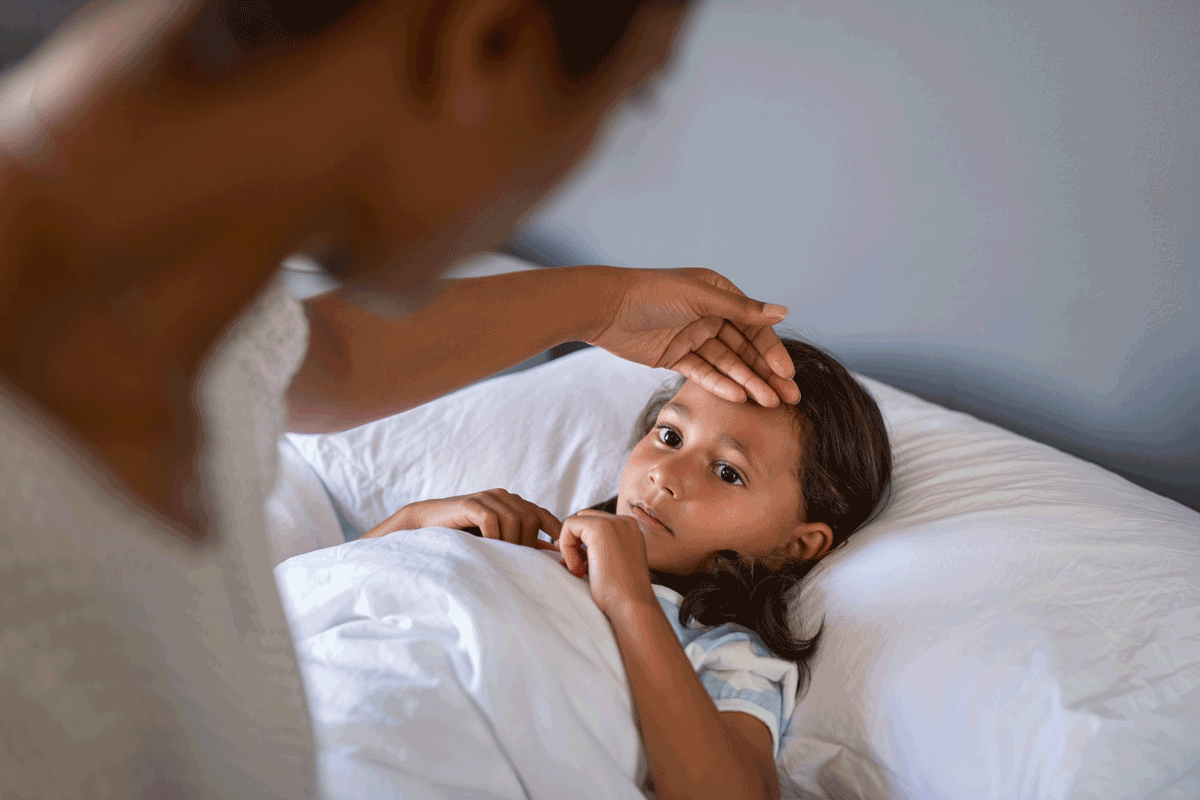Last Updated on October 21, 2025 by mcelik
Knowing if a child’s temperature is normal or if they have a fever is key for parents. When measuring temperature under the arm, or axillary measurement, it’s usually between 97.8 °F and 99.5 °F (36.5 °C to 37.5 °C). Understanding the celsius to fahrenheit conversion helps interpret these readings accurately. Keep in mind that axillary temperatures can be slightly lower than other methods, so if the reading is 99 °F (37.2 °C) or higher, it may indicate a fever in children.

A temperature of 98.6 °F is within this range. This means it’s a normal body temperature for kids. It’s important to know what a normal temp is to check a child’s health.
Knowing the normal body temperature ranges in kids is key for parents. It helps them spot when their child might be sick. Normal body temperature is between 97 °F (36.1 °C) and 99 °F (37.2 °C). But it can change due to age, how active they are, and the time of day.
Body temperature changes throughout the day. It’s usually lower in the morning and higher in the late afternoon or evening. They can be affected by many things.
Several things can change a child’s body temperature, including:
For example, 20 degrees Celsius is the same as 68 °F. Knowing how temperature scales work helps parents understand when their child’s temperature is okay or not.

Knowing when a child has a fever is key for parents. Fever is a sign that might mean a child is sick or has an infection. But what temperature is seen as a fever?
Doctors say a fever in kids is when their body temperature goes up. They call it a fever if the underarm temperature is 99 °F (37.2 °C) or higher. This rule helps figure out if a child’s temperature is too high.
Many things can change how hot a child feels, like their age, how active they are, and where they are. But the fever line stays about the same for all ages.
A temperature of 98.6 °F under the armpit is usually okay. It’s below the fever line of 99 °F. So, an underarm temperature of 98.6 °F doesn’t mean a child has a fever.
It’s important to measure a child’s temperature correctly to know if they have a fever. There are many ways to do this, depending on the child’s age and how well they can cooperate. The equipment you have also plays a role.
Measuring temperature in the underarm is a common method. It’s easy and doesn’t hurt. But it might not always show the exact temperature. Make sure the thermometer is in the right spot and the child’s arm is close to their body for a better reading.
For older kids, you can use an oral thermometer. Just put it under their tongue. Rectal thermometers are more invasive but accurate for babies and young kids. Always use a digital thermometer for rectal use and keep it clean.
Temporal artery thermometers check the forehead temperature. Tympanic thermometers look at the ear canal. These are quick and might be more comfortable for kids. But they need to be used correctly for accurate results.
In summary, there are many ways to measure a child’s temperature. Each has its own benefits and drawbacks. Knowing these can help parents pick the best method for their child.
Pediatric care often involves understanding different temperature scales. While many countries use Celsius as the standard unit of temperature, others, like the United States, commonly use Fahrenheit. Converting between these two scales is essential for understanding a child’s temperature reading.
The formula to convert Celsius to Fahrenheit is: °F = ( °C × 9/5) + 32. For example, to convert 30 degrees Celsius to Fahrenheit, you would calculate (30 × 9/5) + 32, which equals 86 °F. To convert 40 degrees Celsius to Fahrenheit, you calculate (40 × 9/5) + 32, resulting in 104 °F. This formula helps quickly identify if a child’s temperature is normal or if they have a fever.
Having a quick reference chart can be helpful for parents and caregivers. Here is a simple chart for common pediatric temperature conversions:
This chart shows common conversions, making it easier to understand a child’s temperature. For example, knowing that 37 °C equals 98.6 °F helps determine if a child has a fever.
It’s important to know when your child’s fever needs a doctor. Fever is a common sign of infection in kids. It’s key to know when it’s time to worry.
Fever rules change with age. Babies under 3 months need a doctor if their fever goes over 100.4 °F (38 °C). Kids between 3 to 6 andnths can have a fever up to 102 °F (39 °C) at home. But should see a doctor if it gets worse or stays high.
Kids over 6 months can handle higher fevers. But, if their fever goes over 104 °F (40 °C), watch them closely.
Some symptoms with fever mean you should see a doctor right away. These include a bad headache, stiff neck, trouble breathing, or a rash. Also, look out for dehydration signs like fewer wet diapers, dry mouth, or feeling very tired.
If your child is very upset, having a seizure, or seems very sick, get help fast.
Knowing these rules helps parents and caregivers take good care of their kids. It ensures they get medical help when they need it.
Knowing how accurate different ways to measure temperature are is key for parents and caregivers. It’s vital to measure a child’s temperature rectally if they have a fever. There are many ways to do this, each with its own level of trustworthiness.
Underarm, or axillary, temperature checks are popular because they’re easy and don’t hurt. But, they’re not as reliable as other methods. This is because the thermometer is outside the body, making it more affected by the environment. Studies have found that underarm readings can be up to 1 °C lower than the body’s true temperature. This can lead to wrong guesses about fever.
To be sure about fevers, you can use other ways to check temperature. Oral, rectal, temporal, and tympanic methods are more accurate than underarm readings. For example, rectal temperatures are often seen as a good way to measure the body’s core temperature. It’s important to use the right technique when using these methods to get accurate results. Also, knowing how to convert between Celsius and Fahrenheit, like from f to c or Celsius to f, can help understand temperature readings in different units.
By knowing the good and bad of different temperature measuring methods, parents and caregivers can make better choices for their child’s health.
Dealing with low-grade temperatures in kids is all about finding the right balance. It’s about knowing when to treat and when to watch closely. Fevers that are not too high, between 100.4 °F and 102.2 °F, are common in children. They can happen for many reasons, like infections or when they get shots.
Not every low-grade fever needs a doctor’s help. It depends on the child’s age, health, and any other symptoms they might have. For example, babies under 3 months with a fever over 100.4 °F need to see a doctor right away.
For older kids, if they have a fever and are also feeling very sick, they need to see a doctor, too. This includes symptoms like trouble breathing, a bad headache, or a stiff neck.
For mild fevers, taking care of your child at home can work well. Make sure they drink lots of fluids to stay hydrated. Dress them in light clothes to help them cool down.
Using a lukewarm bath can also help lower their fever. If a doctor says it’s okay, you can give them over-the-counter medicines like acetaminophen.
It’s very important to follow the right dosage for any medicine. Always check with a doctor if you’re not sure. By knowing when to watch and when to act, parents can help their kids feel better and know when to get medical help.
Knowing what a normal body temperature is and when your child has a fever is key. Normal body temperature is between 97.7 °F and 99.5 °F. A fever is when the body temperature is over 100.4 °F.
Getting an accurate temperature is important. You can use different methods like underarm, oral, rectal, temporal, and tympanic. Each method has its own level of accuracy.
If your child is under three months old and has a fever, you should get medical help right away. Also, watch for signs like irritability, trouble breathing, or not wanting to eat. These are serious signs that need immediate attention.
By understanding your child’s temperature and acting quickly, you can keep them safe and healthy. If you’re ever unsure, always talk to a healthcare professional.
A normal body temperature for a child is about 98.6 °F. This can vary a bit from one child to another. For younger kids, underarm temperatures are often used. A reading of 98.6 °F is considered normal.
To change Celsius to Fahrenheit, use this formula: °F = ( °C × 9/5) + 32. For example, 37 °C is 98.6 °F. You can also use a conversion chart for common temperatures.
A fever in children is when their temperature is over 100.4 °F (38 °C) when taken rectally. Underarm temperatures might be a bit lower. A reading above 99 °F (37.2 °C) could also mean a fever.
There are many ways to measure a child’s temperature. These include underarm, oral, rectal, temporal, and tympanic measurements. Each method has its own benefits and drawbacks. The right method depends on the child’s age and needs.
Be worried if your child is under 3 months old and has a fever. Also, watch for symptoms like trouble breathing, vomiting, or feeling very tired. Age and symptoms are key to deciding if you need to see a doctor.
For low-grade temperatures, you can try home care, such as keeping them hydrated and comfortable. But if the fever doesn’t go away or if your child has other symptoms, you should see a doctor.
Underarm temperature readings might not be as reliable as rectal or oral ones. If you think your child has a fever, it’s best to check with another method.
Children’s normal temperature is usually between 36-37 °C. But it can vary a bit from one child to another.
You should see a doctor if your child has a high fever or shows signs of distress. Age and symptoms are important to consider.
Yes, you can use temporal or tympanic thermometers on children. But make sure to follow the instructions and use it correctly for accurate readings.
Subscribe to our e-newsletter to stay informed about the latest innovations in the world of health and exclusive offers!